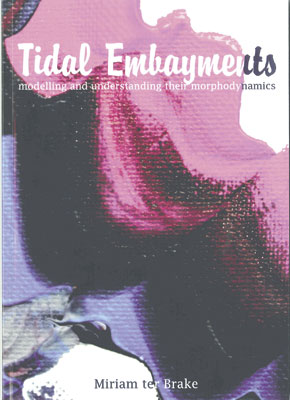“I don’t have the illusion that many of my friends and relatives will read my thesis,” Dr Miriam ter Brake says, laughs. “It’s too technical for that.
But now at least when I hand it over to them they have a nice cover – one that catches the eye. What you see here is just a little corner of one of my father’s paintings. He’s very proud that I used his work, though at first he had to get used to the colours, which my sister slightly changed with Photoshop. I really like this little corner because the pencil strokes resemble the complicated patterns that occur on the seafloor in tidal embayments. For my PhD research I developed an idealised model that helps gain a better understanding of the development and evolution of channel and shoal patterns in short tidal embayments.”
Miriam ter Brake, ‘Tidal embayments, modelling and understanding their morphodynamics’, 15 March 2011, PhD supervisor Professor Arnold Heemink.
Huize Gerrit, Van Hasseltlaan 80-89, has a new tradition: each new housemate must bring a handful of ants with them. For some time now, an Antwork has been displayed on top of the refrigerator in the student house’s communal living room: it’s a small box made of transparent plexiglas sheets with blue-colored gel between them. The gel contains food for the ants, which dig tunnels in search of this food. The ever-expanding tunnel system also serves as a decorative art piece, which can be illuminated from below. Leon Derks, a mechanical engineering student, came across the Antwork on a website for gadgets. “I wanted to buy it as a surprise, but then I thought I better ask my housemates first.” Research was hastily conducted. “On youtube there are accelerated videos showing Antworks that were filmed over a period of two months. You can then see how the beautiful tunnels are made.”
The housemates used an old cooking pan and spoon to capture the first ants. “The kit’s special ant trapping canister proved to be impractical – it sure wasn’t invented in Delft.” There are also videos online showing how to catch ants, says housemate Marleen van Beuzekom: “But you can also buy ants at the pet shop, with the benefit of this being that you then know how old and what race they are.”
Derks: “We want to add other races to the ant community, to see if they work together or just fight. We also have a magnifying glass for studying the ants closely.” A piece of paper is placed across the transparent roof: “The roof has four air holes in it, but a few ants quickly discovered them. A couple of ants died and were brought to the top by the other ants, so that we could remove them.”



Comments are closed.